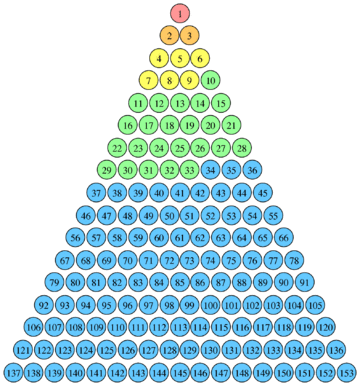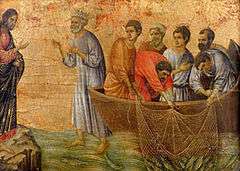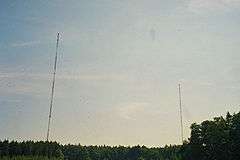153 (number)
| ||||
|---|---|---|---|---|
| Cardinal | one hundred fifty-three | |||
| Ordinal |
153rd (one hundred and fifty-third) | |||
| Factorization | 32× 17 | |||
| Divisors | 1, 3, 9, 17, 51, 153 | |||
| Roman numeral | CLIII | |||
| Binary | 100110012 | |||
| Ternary | 122003 | |||
| Quaternary | 21214 | |||
| Quinary | 11035 | |||
| Senary | 4136 | |||
| Octal | 2318 | |||
| Duodecimal | 10912 | |||
| Hexadecimal | 9916 | |||
| Vigesimal | 7D20 | |||
| Base 36 | 4936 | |||
153 (one hundred [and] fifty-three) is the natural number following 152 and preceding 154.
Mathematical properties

The number 153 has several interesting mathematical properties. 153 is the sum of the first 17 integers and is also the sum of the first five positive factorials, 1! + 2! + 3! + 4! + 5!. The number 153 is associated with the geometric shape known as the Vesica Piscis or Mandorla. Archimedes, in his Measurement of a Circle, referred to this ratio (153/265), as constituting the "measure of the fish", this ratio being an imperfect representation of 1/√3.
As a triangular number, 153 is the sum of the first 17 integers, and is also the sum of the first five positive factorials:.[1]
The number 153 is also a hexagonal number, and a truncated triangle number, meaning that 1, 15, and 153 are all triangle numbers.
The distinct prime factors of 153 add up to 20, and so do the ones of 154, hence the two form a Ruth-Aaron pair.
Since , it is a 3-narcissistic number, and it is also the smallest three-digit number which can be expressed as the sum of cubes of its digits.[2] Only five other numbers can be expressed as the sum of the cubes of their digits: 0, 1, 370, 371 and 407.[3] It is also a Friedman number, since 153 = 3 × 51, and a Harshad number in base 10, being divisible by the sum of its own digits.
The Biggs–Smith graph is a symmetric graph with 153 edges, all equivalent.
Another interesting feature of the number 153 is that it is the limit of the following algorithm:[4][5]
- Take a random positive integer, divisible by three.
- Split that number into its base 10 digits.
- Take the sum of their cubes.
- Go back to the second step.
An example, starting with the number 84:
In the Bible

The Gospel of John (chapter 21:1–14) includes the narrative of the miraculous catch of 153 fish as the third appearance of Jesus after his resurrection.[6]
The precision of the number of fish in this narrative has long been considered peculiar, and many scholars, throughout history, have argued that 153 has some deeper significance. Jerome, for example, wrote that Oppian's Halieutica listed 153 species of fish, although this could not have been the intended meaning of the Gospel writer because Oppian composed Halieutica after the Gospel text was written, and at any rate never gave a list of fish species that clearly adds up to 153.[7][8] It has also been noted that the Tetragrammaton occurs 153 times in the Book of Genesis.[9]
Augustine of Hippo argued that the significance lay in the fact that 153 is the sum of the first 17 integers (i.e. 153 is the 17th triangular number), with 17 representing the combination of divine grace (the 7 gifts of the Spirit) and law (the Ten Commandments).[10][11] Theologian D. A. Carson discusses this and other interpretations and concludes that "If the Evangelist has some symbolism in mind connected with the number 153, he has hidden it well,"[12] while other scholars note "No symbolic significance for the number of 153 fish in John 21:11 has received widespread support."[13]
Writers claiming a major role for Mary Magdalene have noted that in Greek isopsephy her epithet "η Μαγδαληνή" bears the number 8 + 40 + 1 + 3 + 4 + 1 + 30 + 8 + 50 + 8 = 153, thus, it is suggested, revealing her importance.[14] Similarly, the phrase "τὸ δίκτυον" (the net) used in the passage bears the number 1224 = 8 × 153,[14] as do some other phrases. The significance of this is unclear, given that Koine Greek provides a choice of several noun endings[15] with different isopsephy values.[16] The number 153 has also been related to the vesica piscis, with the claim that Archimedes used 153 as a "shorthand or abbreviation"[14] for the square root of 3 in his On the Measurement of the Circle. However, examination of that work[17] does not find the number 153 used in that way.[4]
Although, John R. Hellmann gives solid argumentation that the number 153 was used by John as a metaphor to allude to the wisdom of Archimedes. The misleading reason that the number 153 does not look prominent in a modern discussion on Archimedes is because of the use of the relatively modern horizontal fraction bar.
However, the early Greeks wrote their fractions or ratios in linear form. They could not have used the horizontal fraction bar. The use of the horizontal fraction bar came much later. The horizontal fraction bar is first attested in the work of Al-Hassār in A.D. 12th Century.
See explanation at web site below of why in the time John's Gospel was written the number 153, as used in Archimedes work on Pi, was more obviously prominent.
See: http://www.defendingthebride.com/ss/fish/archimedes.html#arch
And, according to that position, John was able to gently imply that ALL wisdom comes from and through Jesus. By doing this, it is argued, John addressed the objection of the Greeks in a pastoral way.
See: http://www.defendingthebride.com/ss/fish/conclusion.html
Evagrius Ponticus referred to the catch of 153 fish, as well as to the mathematical properties of the number (153 = 100 + 28 + 25, with 100 a square number, 28 a triangular number and 25 a circular number) when describing his 153-chapter work on prayer.[18] Louis de Montfort, in his fifth method of saying the Rosary, connects the catch of 153 fish with the number of Hail Marys said (3 plus 15 sets of 10),[19] while St Paul's School in London was founded in 1512 by John Colet to teach 153 poor men's children, also in reference to the catch.[20]
In the military

- HMAS Stuart (FFH 153) is an Anzac class frigate of the Royal Australian Navy
- HMAS Whyalla (J153) was a Bathurst class corvette of the Royal Australian Navy during World War II
- JDS Yūgiri (DD-153) is an Asagiri class destroyer of the Japanese Maritime Self-Defense Force
- USNS Cumberland (T-AO-153) was a United States Navy auxiliary ship during the Vietnam War
- USS Asphalt (IX-153) was a United States Navy Trefoil class concrete barge during World War II
- USS Bernadou (DD-153) was a United States Navy Wickes class destroyer during World War II
- USS Buoyant (AM-153) was a United States Navy Admirable minesweeper ship during World War II
- USS Compass Island (AG-153) was a United States Navy naval fighting ship during World War II
- USS General R. M. Blatchford (AP-153) was a United States Navy General G. O. Squier transport ship during World War II
- USS Laurens (APA-153) was a United States Navy Haskell class attack transport during World War II
- USS Reuben James (DE-153) was a United States Navy Buckley class destroyer escort during World War II
- USS S-42 (SS-153) was a United States Navy S-class submarine during World War II
- The 153d Airlift Wing is a unit of the United States Air Force, located at Cheyenne Regional Airport, Cheyenne, Wyoming.
- The 153d Air Refueling Squadron is a unit of the Mississippi Air National Guard, flying the KC-135 Stratotanker
- The 153rd Illinois Volunteer Infantry Regiment was an infantry regiment that served in the Union Army during the American Civil War
- The Russian Soviet Polikarpov I-153 Chaika ("Seagull") was a late 1930s biplane fighter which saw combat during World War II
In transportation
- British Rail Class 153 is a single-car diesel multiple unit train
- Caledonian Airways Flight 153 from Douala International Airport, Douala, Cameroon crashed on March 4, 1962
- The Peugeot Type 153 car, produced between 1913 and 1925
- 153rd Street station on Metra's SouthWest Service in Orland Park, Illinois
In sports
- Australian rules footballer Scott Hodges had a SANFL season goal kicking record of 153 in 1990
In radio and TV

In other fields
153 is also:
- The year AD 153 or 153 BC
- The year 153 AH in the Islamic calendar that corresponds to 769 – 770 CE
- The code for malignant neoplasm of the colon in the International Statistical Classification of Diseases and Related Health Problems
- The code for "mental processes & intelligence" in the Dewey Decimal Classification
- A reference to a comet (153P/Ikeya-Zhang) discovered in 2002
- A reference to a large asteroid with a dark surface (153 Hilda) in the outer Main belt
- The ordinal number of the coat of arms of Komi Republic in the State Heraldic Register of the Russian Federation
- The number of combined Arabic and Persian Hidden Words in the Bahá'í Faith.
- The atomic number of an element temporarily called Unpenttrium
- A sonnet by William Shakespeare
- The U.S. Bureau of Transportation Statistics' world area code for Nicaragua[22]
- The number of aphorisms outlined by Chr. Pack in 153 Chymical Aphorisms[23]
See also
| Wikimedia Commons has media related to 153 (number). |
- Article 153 of the Constitution of Malaysia
- Gregg v. Georgia, 428 U.S. 153 (1976)
- List of highways numbered 153
- United Nations Security Council Resolution 153
- United States Supreme Court cases, Volume 153
References
- ↑ Wells, D. The Penguin Dictionary of Curious and Interesting Numbers London: Penguin Group. (1987): 140–141.
- ↑ Gupta, Shayam Sunder. "Curious Properties of 153". Retrieved June 26, 2009.
- ↑ OEIS:A046197
- 1 2 Catch of the Day (153 Fishes) at mathpages.com.
- ↑ OEIS:A165330
- ↑ Biblegateway John 21:1–14
- ↑ Grant, Robert McQueen (1999). Early Christians and Animals. Routledge. p. 23. ISBN 0-415-20204-3.
- ↑ Grant, Robert M. (October 1949). "One Hundred Fifty-Three Large Fish (John 21:11)". Harvard Theological Review. 42 (4): 273–275. doi:10.1017/s0017816000024329. JSTOR 1508507.
- ↑ Jewish Encyclopedia: TETRAGRAMMATON.
- ↑ Jason Byassee, Praise Seeking Understanding: Reading the Psalms with Augustine, Wm. B. Eerdmans Publishing, 2007, p. 130, ISBN 0-8028-4012-4.
- ↑ John E. Rotelle (ed) and Edmund Hill (tr), The works of Saint Augustine: A Translation for the 21st Century, Part 3, Volume 7 (Sermons: On the Liturgical Seasons), p. 112, ISBN 1-56548-059-7.
- ↑ D. A. Carson, The Gospel According to John (Pillar Commentaries Series), Wm. B. Eerdmans Publishing, 1991, p. 673, ISBN 0-85111-749-X.
- ↑ Leland Ryken, Jim Wilhoit, Tremper Longman, Colin Duriez, Douglas Penney, and Daniel G. Reid, Dictionary of Biblical Imagery (Fish), InterVarsity Press, 1998, p. 290, ISBN 0-8308-1451-5.
- 1 2 3 Margaret Starbird, Magdalene's Lost Legacy: Symbolic Numbers and the Sacred Union in Christianity, Inner Traditions / Bear & Company, 2003, pages 49 and 139, ISBN 1-59143-012-7.
- ↑ J.W. Wenham, The Elements of New Testament Greek, Cambridge University Press, 1965.
- ↑ For example, ἰχθύς (fish) has isopsephy values of 1219, 1069, 1289, 1029, 1224, 1220, 1869, 1229, and 1279 with the different noun endings on p. 124 of Wenham, and a further range of possibilities when the definite article is added.
- ↑ Heath, Thomas Little (1897), The Works of Archimedes, Cambridge University, pp. lxxvii ; 50, retrieved January 30, 2010
- ↑ William Harmless, Desert Christians: An Introduction to the Literature of Early Monasticism, Oxford University Press, 2004, pp. 320–341, ISBN 0-19-516222-6.
- ↑ Montfort.org.uk, "its fruitfulness as shown in the net that St. Peter by order of Our Lord threw into the sea and which though filled with 153 fish did not break."
- ↑ Peter Cunningham, Modern London; or, London as it is, 1851, p. 193.
- ↑ Table of transmission frequencies
- ↑ World-airport-coedes.com
- ↑ 153 Chymical Aphorisms.
External links
- The Number 153 at The Database of Number Correlations
- Curious Properties of 153 by Shyam Sunder Gupta
- The 153 Club for Sahara Desert Travellers
- Experimental Aircraft Association, Chapter 153, Schaumburg, Illinois
- The 153 Project
- Meaning of Numbers in the Bible: Number 153
- London Bus Route 153